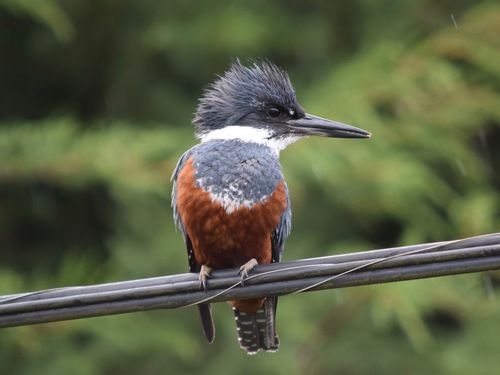
Ringed Kingfisher
The Ringed Kingfisher (*Megaceryle torquata*) is a striking, relatively large kingfisher species found throughout much of the Americas. It plays an important ecological role as a predator of fish and aquatic invertebrates, helping to regulate populations within its freshwater and coastal habitats. Unlike many smaller kingfisher species, the Ringed Kingfisher is known for its robust build, loud rattling call, and conspicuous perching behavior. It holds no particular widespread cultural significance, but its vibrant colors and impressive fishing skills make it a favorite among birdwatchers.
38-42 cm
Length
68-78 cm
Wingspan
Least Concern
Conservation Status
Distribution
The Ringed Kingfisher is found from southern Texas in the United States, through Mexico and Central America, and throughout much of South America, as far south as Tierra del Fuego. It is largely non-migratory, though some populations may make local movements in response to water availability.
Lifespan
Up to 8 years in the wild. Captive lifespans are not well documented.
Ringed Kingfisher's Habitat
Habitat Types
Rivers, Streams, Lakes, Estuaries, Mangrove swamps, Coastal lagoons
Climate Zones
Tropical, Subtropical, Temperate
Adaptations
Ringed Kingfishers have strong, pointed bills for spearing fish. Their eyes are adapted for clear vision both above and below water, crucial for spotting prey. They possess relatively short legs and strong feet, adapted for perching on branches overhanging water.
Variations
Three subspecies are generally recognized: *M. t. torquata*, *M. t. stictipennis*, and *M. t. stellata*. These differ slightly in size and plumage details, primarily in the extent of rufous coloration and spotting.
Appearance
Breeding Plumage
Plumage is largely consistent year-round, with no distinct breeding plumage.
Seasonal Feather Changes
Minimal seasonal variation.
Sex Based Plumage Differences
Males have a broad rufous breast band and underparts. Females have a bluish-gray breast band and a narrower rufous band below that, separated by white.
Notable Features
Large, shaggy crest, Prominent white collar, Heavy, black bill, Slate-blue upperparts
Diet and Feeding
Primary Foods
Small fish, Crustaceans, Aquatic insects, Amphibians, Small reptiles (occasionally)
Foraging Behavior
The Ringed Kingfisher typically hunts from a perch overlooking the water. It will also hover, albeit less skillfully than smaller kingfishers, before plunging headfirst to capture prey. It beats larger prey against a perch before swallowing it headfirst.
Specializations
Their strong bill is well-suited for capturing and holding slippery prey. Their eyes have adaptations to minimize glare and see clearly underwater.
Seasonal Diet Variations
Diet may shift slightly depending on prey availability. During periods of high water or turbidity, they may rely more on crustaceans and other non-fish prey.
Behavior
Social Structure
Generally solitary or found in pairs. They are not typically found in large flocks, except occasionally at abundant food sources.
Communication
Loud, rattling call, Chattering calls, Visual displays involving crest raising and wing flicking
Migration
Largely resident (non-migratory), but may undertake local movements in response to water levels or food availability.
Territorial or Group Behaviors
Highly territorial, defending stretches of river or shoreline. They will aggressively chase away intruders, including other kingfishers.
Conservation
Threats
Habitat destruction (deforestation, dam construction, water pollution), Human disturbance (near nesting sites), Pesticide contamination (affecting prey populations)
Protection Programs
General protection of waterways and riparian habitats, Some protected areas encompass Ringed Kingfisher habitat
Local National Laws
Protected under the Migratory Bird Treaty Act in the United States. Specific protections vary by country throughout its range.
Population Trend
Stable
Population Estimates
The global population is estimated to be 5-50 million individuals.
Interesting Facts
They often excavate their nesting burrows in collaboration
Both the male and female participate in digging the burrow, which can be up to 8 feet long.
They are efficient fishers
Ringed Kingfishers have a high success rate when diving for prey, thanks to their excellent vision and powerful bills.
Young birds regurgitate pellets
Like many other fish-eating birds, young Ringed Kingfishers regurgitate pellets containing indigestible fish bones and scales.
Faqs about Ringed Kingfisher
What is the difference between a Ringed Kingfisher and a Belted Kingfisher?
The Ringed Kingfisher is larger, with a more massive bill and different plumage. Males have a rufous breast, while female Ringed Kingfishers have a blue-gray band above a rufous band. Belted Kingfishers have a blue-gray breast band in males and a rufous band across the belly in females.
Where can I see a Ringed Kingfisher?
Look for them perched on branches or wires overhanging rivers, lakes, and coastal areas within their range. They are often quite conspicuous due to their size and loud calls.
Do Ringed Kingfishers migrate?
They are primarily non-migratory, but some populations may move locally in response to changing water levels or food availability.
Copyright @ Nature Style Limited. All Rights Reserved.
 English
English